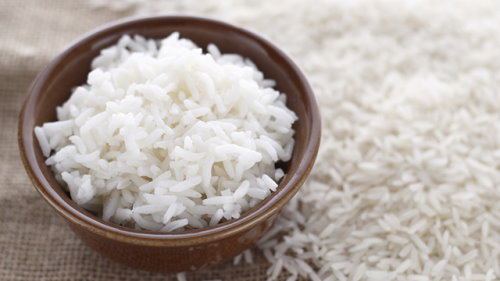Rice has been a staple food for generations. It’s inexpensive, easy to make, and filling. It’s also remarkably versatile, with a mild flavor that fits in with just about any type of cuisine—from American to Indian to Italian to Mexican and so many more. And if you choose brown rice over white rice, you get a bit more nutrition and fiber. However, if you’re looking to limit carbohydrates or increase fiber and protein, there’s a surprising number of healthy rice alternatives that can effortlessly take the place of rice on the menu.
BREAKING: Shed 42 lbs In 30 Days With This Simple Night-time Pill
Here are our favorite healthy rice alternatives to fill up your plate and your belly:
10 Healthy Rice Alternatives
1. Cauliflower Rice
Calories per cup: 27; protein: 2 grams; fat 0 grams; carbs 5 grams; fiber: 2 grams
If you’re following any low-carb diet (or just decreasing carb calories), look no further than riced cauliflower. You can easily make your own with a food processor or save yourself a step with pre-riced cauliflower from either the fresh or frozen section of your grocery store. As a bonus, cauliflower rice provides fiber as well as nutrients like vitamin C, folate, and vitamin K.
To see how well cauliflower rice can fit into your menu plan, consider adding cauliflower tabouli, chicken alfredo casserole, green chicken curry recipe, or (my personal favorite) Tex-Mex cauliflower rice.
Another great low-carb option is broccoli rice, which is also a great source of fiber, plant protein, and iron with a similar nutrient content. It can also be made at home with a food processor or vegetable grater or found in the freezer section of many grocery stores.
2. Sweet Potato Rice
Calories per cup: 110; protein: 2 grams; fat 0 grams; carbs 23 grams; fiber: 5 grams
Another lesser-known option for a lower carb vegetable “rice” is sweet potato rice, which provides vitamin C, fiber, and a wealth of other nutrients. It’s also dairy-free, gluten-free, and versatile for a wide range of recipes and diets.
To make sweet potato rice, use a food processer to shred peeled potatoes until they resemble rice kernels. Then cook the “rice” with a little oil in a skillet set over medium heat. Cook for 20 to 30 minutes while stirring occasionally until the potato is lightly caramelized and smaller. (If you find the “rice” is starting to stick, you can loosen it up with a little added water, but don’t add too much, as this could transform your “rice” into a mash.) Use your cooked sweet potato rice just as you would any of the other healthy rice alternatives.
3. Quinoa
Calories per cup: 120; protein: 4.4 grams; fat 1.9 grams; carbs 21.3 grams; fiber: 2.8 grams
This seed, that looks like a grain, is a popular rice alternative. It’s gluten-free, is a complete protein, and is also rich in fiber and nutrients like B vitamins, iron, calcium, zinc, and magnesium. It goes seamlessly in virtually any recipe that typically uses rice.
To see how easy and versatile it is to make and use, here are some tasty recipes to get you started: roasted beet and kale quinoa salad, quinoa fruit salad, quinoa pizza bites, and spring chicken bowl.
4. Couscous
Calories per cup: 174; protein: 6 grams; fat 0 grams; carbs 36 grams; fiber: 2 grams
Couscous is neither a grain nor a seed. Instead, it’s pasta made from semolina flour and shaped into tiny balls. If your diet is not gluten-free, couscous is a good alternative to rice as it provides a similar amount of fiber and nearly twice as much protein. Plus, couscous provides essential B vitamins. Perhaps best of all, couscous is fast-cooking and very versatile.
Making couscous takes roughly ten minutes. Start by boiling one cup of water or broth. You can also add a dash of salt and a drizzle of olive oil or a touch of butter. Then stir in one cup of couscous. Remove the pan from the heat and cover with a lid. Allow the couscous to cook for five minutes and then fluff with a fork. Serve on its own, as part of a rainbow veggie salad, or in any dish that calls for cooked rice.
5. Orzo
Calories per half cup: 210; protein: 7 grams; fat 1 gram; carbs 41 grams; fiber: 2 grams (though it varies by brand)
Another healthy rice alternative is orzo, which will keep you full and energized for hours, especially when paired with vegetables and a quality protein source. While orzo is again a type of pasta typically made with semolina flour, it has a similar look and feel to rice or, more accurately, barley. The word orzo actually comes from the Italian word for barley. (Gluten-free varieties of orzo are also available at many stores.)
This option is also quick cooking. Simply bring a pot of water to a boil, add your orzo, bring the water back to a boil, and cook for 8 to 10 minutes (the longer, the more tender). Drain in a colander, and then serve or add it to your favorite recipe. Some tasty options include a Mediterranean orzo and shrimp salad or a vegan grain bowl.
6. Amaranth
Calories per cup: 251; protein: 9.3 grams; fat 5.2 grams; carbs 46 grams; fiber: 5.2 grams
Another protein-rich, gluten-free rice alternative is the whole grain amaranth. Interestingly, this ancient grain provides three times more fiber than wheat. It’s also a good source of iron, phosphorus, calcium, and magnesium.
While we don’t have any specific recipes, amaranth can be used one to one in recipes that typically use rice. Cooking instructions and timing are also similar. Bring two to three cups of water to a boil before adding one cup of amaranth. Then reduce the heat and simmer, covered, for around 20 minutes. You can also use a pressure cooker or rice cooker to prepare.
7. Teff
Calories per half cup: 354; protein: 13 grams; fat 2.3 grams; carbs 71 grams; fiber: 8 grams
Another gluten-free ancient grain that makes a healthy rice alternative is teff. Native to Ethiopia, teff is high in protein, fiber, and nutrients like calcium, magnesium, manganese, thamin, and vitamin C. Teff is also a good source of resistant starch, which is a type of fiber that helps balance blood sugar levels, maintain weight, and support a healthy gut microbiome.
Teff can be used in a variety of recipes due to its mild, nutty flavor. It makes a simple, delicious porridge and can also be used instead of nuts and seeds in salads and other recipes as it’s similar in texture to poppy seeds. It can also be used to thicken soups and stews or in place of rice in pilafs or curries.
8. Farro
Calories per cup: 337; protein: 15 grams; fat 2 grams; carbs 71 grams; fiber: 11 grams
Farro is another ancient grain. This one, however, is wheat based, so it’s not a good option for folks who are going gluten-free. If that isn’t a concern, though, farro is a great healthy rice alternative as it’s high in fiber and protein. In fact, this super grain provides more protein and fiber than quinoa.
Preparing whole farro is similar to how you cook rice. Start with a large pot of boiling water and add farro and a dash of salt. Turn down the heat and simmer for 35 to 40 minutes (or until tender). Drain the farro with a strainer and then fluff before serving.
Other ancient grains to consider include freekeh and millet for their rich nutty flavors. You can even include several grains in one dish for an ancient grains salad medley.
9. Barley
Calories per half cup: 354; protein: 12.5 grams; fat 2.3 grams; carbs 73.5 grams; fiber: 17.3 grams
One of the first grains farmed (archeological research found barley was grown more than 10,000 years ago in ancient Egypt), barley is often thought of as malted for beer. Hulled barley, however, is a healthy fiber-rich grain that’s high in protein, thiamine, niacin, magnesium, manganese, selenium, and other nutrients. It’s also a source of the soluble fiber beta-glucan, which has been found to help lower cholesterol and help stabilize blood sugar.
Barley is ready for the lunch or dinner plate within 25 to 30 minutes. Just boil one part of barley to 4 parts of water. Reduce the heat to medium and continue cooking until it’s tender. Drain and serve or add to your recipe.
10. Bulgur Wheat
Calories per cup: 151; protein: 6 grams; fat 0 grams; carbs 34 grams; fiber: 8 grams
Many of the healthier rice alternatives on this list have been higher in calories than rice. Not bulgur wheat. This small grain commonly used in tabbouleh is low in calories yet provides the nutty, grainy texture and flavor many love. If you’re cutting calories but don’t want to give up grains, bulger wheat may be the right option for you.
TRENDING: Boost Your Memory With This Easy Trick
To cook, add one cup of bulgur wheat to 1 ½ cups of water and bring to a boil. Then cover and cook over low until tender (about 12 minutes). Remove it from the heat and allow it to rest, covered, for another 10 minutes. Fluff with a fork and serve hot.
Healthy Rice Alternatives: A Wrap Up
There are numerous delicious choices when it comes to healthy rice alternatives to fit just about any diet—from low carb to Mediterranean Diet to gluten-free. Greater food variety provides a wider range of nutrients, so feel free to mix and match any of the above options in your favorite recipes. You may be surprised by the wide range of flavors and textures you can enjoy.









